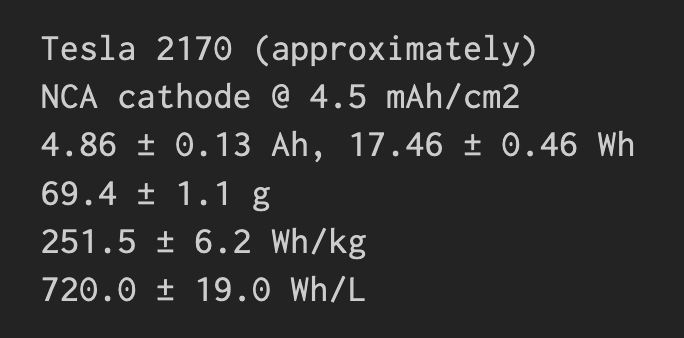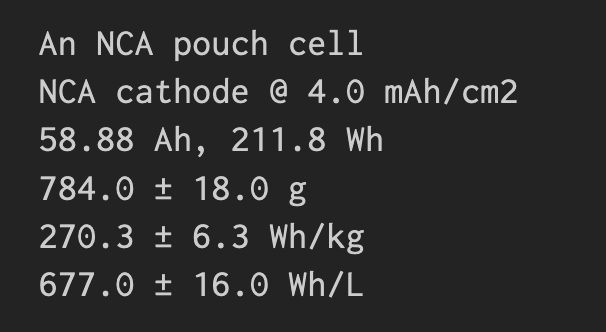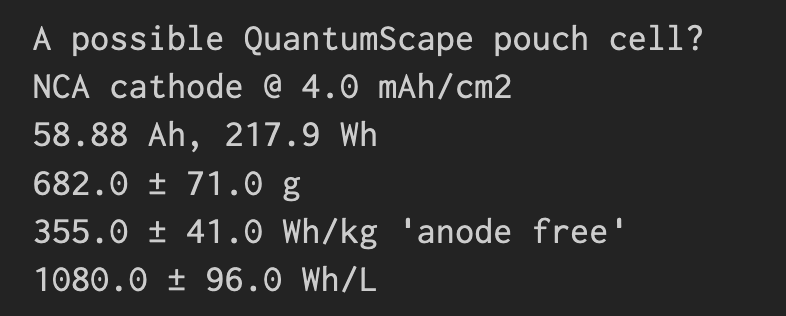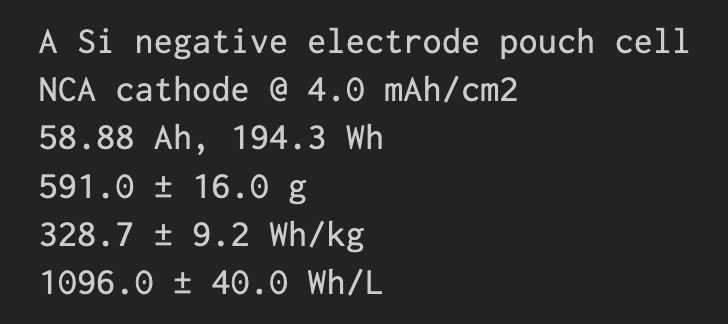
Some additional thoughts and numbers on #QuantumScape. Long story short: my estimate is that an "anode-free" solid state cell should fetch ~350 Wh/kg, in the absence of some new miracle positive electrode. Bit lower than 380-480 Wh/kg QS have stated. Thread... 1/
My starting point for my (medium crude) calculations is Tesla - they have probably the most energy-dense +ve on the market now: NCA w/ 90% Ni and a high capacity of ~4.5 mAh/cm2. My cell model gets pretty close to the Model 3 2170 cell numbers, so it's an ok starting point. 2/ 

My gut feeling is that QS are going to be using a similar Ni-rich electrode, despite mentions of new conversion cathodes - because I think the latter is one technology leap too many for me to believe without any good evidence to the contrary... 3/
In some of their patents, QS make mention of 4 mAh/cm2 tests of their Li electrodes, so I'm going to assume this is their target and is achievable. I'm also assuming these will be pouch cells. So I'm going to model a pouch cell with NCA, 4 mAh/cm2, and guesstimate dimensions 4/
This is what I got, 23 x 16 cm cell with 20 electrode layers. Bit higher gravimetric and bit lower volumetric compared to cylindrical, sounds ok. Not sure I have a good point of comparison to a real cell but capacity-wise this is around the level of many other EV cells now 5/ 

For the solid state cell, I have to make some guesses. I'm assuming the electrolyte layer is 15-25 µm (open Q as to whether this is achievable; current batteries have 10-15 µm plastic separators), and that the electrolyte is dense "LLZO" as again patents might suggest. 6/
And here's my estimate: 355 ± 41 Wh/kg, slightly overlapping with QS's 380-480 Wh/kg. But >1000 Wh/L volumetric (taking into account volume expansion of the cell after the Li is plated). +31% ± 15% gravimetric and +60 ± 14% compared to the Li-ion version 7/ 

Out of interest, here's the same cell but if it would have a pure silicon anode as well, which has been a topic of conversation in the last week - I make it a bit lower gravimetric energy, but around the same volumetric. 8/ 

A big question is how thin can the solid electrolyte membrane really be made? Shaving 10 µm off to reach the level of today's polyethylene separators will add 30 Wh/kg on its own by my numbers. Another is volume expansion, this whole cell would expand ~22% during charge 9/
*If* such cells could be realised, then there's further possible advantages. A solid state cell won't have the same propensity towards thermal runaway (though I don't believe in "intrinsically safe") - so cooling requirements in packs etc could be reduced, saving more weight 10/
Of course, plenty of questions still abound. The only publicly available information points to only relatively small, single layer pouch cells so far. Deployment in a production car in 2025 seems far fetched to me, though they do have strong backing. 11/
I'll be watching with interest. My default position is to be skeptical, but I still think the challenges of SS and Li metal are solvable, and if there is going to be any battery tech offering a big step up from Li-ion, it's probably this or something like it. /end, maybe
P.S.; 480 Wh/kg could be achievable with some very thick electrodes and some very thin (~10 µm) electrolytes, and some optimism about minimising the amount of LLZO in the electrode. Plausible, maybe, but surely very very hard to achieve 

• • •
Missing some Tweet in this thread? You can try to
force a refresh


